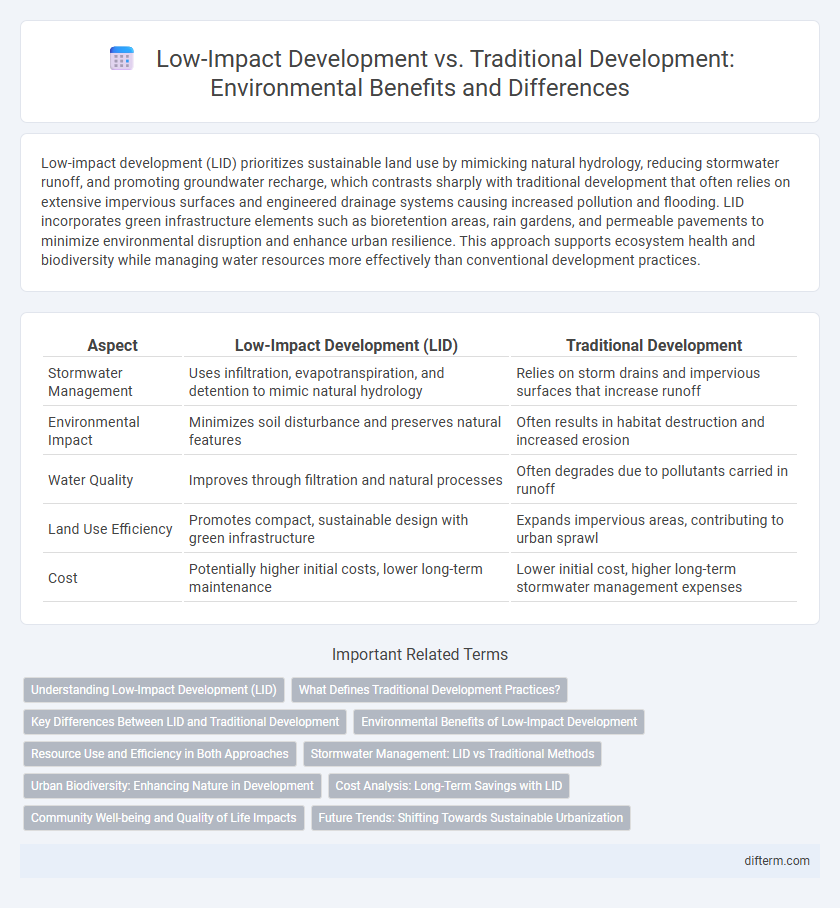Low-impact development (LID) prioritizes sustainable land use by mimicking natural hydrology, reducing stormwater runoff, and promoting groundwater recharge, which contrasts sharply with traditional development that often relies on extensive impervious surfaces and engineered drainage systems causing increased pollution and flooding. LID incorporates green infrastructure elements such as bioretention areas, rain gardens, and permeable pavements to minimize environmental disruption and enhance urban resilience. This approach supports ecosystem health and biodiversity while managing water resources more effectively than conventional development practices.
Table of Comparison
| Aspect | Low-Impact Development (LID) | Traditional Development |
|---|---|---|
| Stormwater Management | Uses infiltration, evapotranspiration, and detention to mimic natural hydrology | Relies on storm drains and impervious surfaces that increase runoff |
| Environmental Impact | Minimizes soil disturbance and preserves natural features | Often results in habitat destruction and increased erosion |
| Water Quality | Improves through filtration and natural processes | Often degrades due to pollutants carried in runoff |
| Land Use Efficiency | Promotes compact, sustainable design with green infrastructure | Expands impervious areas, contributing to urban sprawl |
| Cost | Potentially higher initial costs, lower long-term maintenance | Lower initial cost, higher long-term stormwater management expenses |
Understanding Low-Impact Development (LID)
Low-Impact Development (LID) emphasizes sustainable land use techniques designed to manage stormwater at its source, reducing runoff and improving water quality through practices like green roofs, permeable pavements, and rain gardens. Unlike traditional development, which often relies on extensive stormwater infrastructure and impervious surfaces, LID integrates natural hydrology by preserving vegetation and promoting infiltration. Implementing LID strategies mitigates urban flooding, preserves groundwater recharge, and enhances ecosystem resilience in urban environments.
What Defines Traditional Development Practices?
Traditional development practices prioritize large-scale land alteration, extensive impervious surfaces, and centralized stormwater management systems that often lead to increased runoff and environmental degradation. These methods rely heavily on grading, piping, and channeling water away from development sites, disrupting natural hydrology and reducing groundwater recharge. Typically, traditional development ignores the integration of green infrastructure, resulting in higher risks of flooding, habitat loss, and water pollution compared to low-impact development strategies.
Key Differences Between LID and Traditional Development
Low-impact development (LID) emphasizes sustainable stormwater management by mimicking natural hydrology through techniques such as rain gardens, permeable pavements, and green roofs, reducing runoff and improving water quality. Traditional development typically relies on conventional stormwater infrastructure like curbs, gutters, and storm sewers, which often lead to increased surface runoff and water pollution. LID promotes on-site water infiltration and natural landscape preservation, whereas traditional methods prioritize extensive land grading and impervious surfaces.
Environmental Benefits of Low-Impact Development
Low-impact development (LID) significantly reduces stormwater runoff by mimicking natural hydrology through techniques like rain gardens, permeable pavements, and green roofs, which enhance groundwater recharge and improve water quality. Unlike traditional development that often increases impervious surfaces causing pollution and habitat disruption, LID preserves vegetation and promotes biodiversity, reducing urban heat islands and erosion. Implementing LID strategies supports sustainable urban ecosystems while mitigating the environmental degradation commonly associated with conventional construction methods.
Resource Use and Efficiency in Both Approaches
Low-impact development (LID) emphasizes minimal resource consumption by integrating natural processes like infiltration and evapotranspiration, significantly reducing water runoff and energy use compared to traditional development. Traditional development often relies on impervious surfaces and centralized stormwater management, leading to higher water, energy consumption, and increased pollutant loads. LID techniques enhance resource efficiency by preserving natural hydrology, promoting groundwater recharge, and reducing infrastructure costs, making them a sustainable alternative to conventional practices.
Stormwater Management: LID vs Traditional Methods
Low-impact development (LID) techniques manage stormwater by mimicking natural hydrology through infiltration, evapotranspiration, and reuse, reducing runoff volume and improving water quality on-site. Traditional stormwater methods rely on impervious surfaces and engineered drainage systems that quickly convey runoff to off-site detention or treatment facilities, often causing downstream flooding and pollution. LID approaches promote sustainable urban drainage by integrating green infrastructure like rain gardens and permeable pavements, enhancing groundwater recharge and minimizing environmental impacts compared to conventional piped systems.
Urban Biodiversity: Enhancing Nature in Development
Low-impact development (LID) techniques prioritize preserving and enhancing urban biodiversity by integrating green infrastructure such as rain gardens, green roofs, and permeable pavements that mimic natural hydrology and provide habitat for native species. Traditional development often replaces natural landscapes with impervious surfaces, leading to habitat loss, reduced species diversity, and disrupted ecological networks. Implementing LID practices supports ecosystem services, improves air and water quality, and fosters resilient urban environments that sustain diverse plant and animal populations.
Cost Analysis: Long-Term Savings with LID
Low-impact development (LID) reduces long-term infrastructure and maintenance costs by enhancing natural water absorption and decreasing stormwater runoff compared to traditional development. Implementing LID strategies such as permeable pavements, rain gardens, and green roofs reduces expenses related to stormwater treatment and flood damage repairs. Studies show that these cost savings, combined with increased property values and ecosystem services, make LID a financially sustainable choice over conventional development methods.
Community Well-being and Quality of Life Impacts
Low-impact development practices enhance community well-being by promoting green spaces, reducing stormwater runoff, and improving air quality, which supports healthier living environments. Traditional development often prioritizes impervious surfaces and infrastructure, leading to increased flooding, urban heat islands, and reduced recreational areas that negatively affect quality of life. Integrating sustainable design elements in urban planning preserves natural ecosystems and fosters social cohesion, benefiting long-term community health and resilience.
Future Trends: Shifting Towards Sustainable Urbanization
Low-impact development (LID) emphasizes natural water management techniques that enhance urban resilience and biodiversity, contrasting sharply with traditional development's reliance on hard infrastructure and impervious surfaces. Future trends indicate a decisive shift toward sustainable urbanization, integrating green infrastructure, permeable pavements, and rain gardens to mitigate urban heat islands and reduce stormwater runoff. Advancements in smart city technology and policy frameworks prioritize LID principles, promoting eco-friendly growth that balances economic progress with environmental stewardship.
low-impact development vs traditional development Infographic

 difterm.com
difterm.com